The 5th "Booking Service Guide for Visits"
- The 5th "Booking Service Guide for Visits">
- Postal/Philately Gallery
School Visit Booking - Postal/Philately Gallery
Among the Postal/Philately booking activities, in addition to the ¡§General Guided Visit¡¨, we also provide activities of five main categories, namely ¡§History of Macao Post¡¨, ¡§Foundations of Communication¡¨, ¡§Postal Service¡¨, ¡§Stamps and Collection¡¨ and ¡§General Mathematics¡¨, as well as hands-on ¡§Workshops¡¨. We welcome schools and teachers to select suitable activities for students of different levels. Teachers are also welcomed to visit our Museum prior to the visit of students.
General Guided Visit
After the simple introduction by our Facilitators about the exhibitions of Postal/Philately and Telecommunications Galleries and other facilities, visitors can freely experience the most amusing and popular interactive games in the Museum.
Kind reminder:
- Teachers and students are welcome to bring cameras for photo-taking.
- We appreciate very much that teachers and helpers would assist us in taking care of the students during the visit.
- If seats are needed, please inform us upon reservation.
| Item | Audience |
|---|---|
| S1-001 "Basic Guided Visit" | Primary 1 or above, first visit to the Museum |
| S1-002 "Special Guided Visit" | Special guide for disabled students, Primary 1 or above. |
Thematic Guided Visit
Thematic visits are planned in accordance with the characteristics of our different galleries and the levels of the visiting students. Teachers are welcomed to book our interactive options where our facilitators will create fun learning in different ways to help students learn easily and happily.
Kind Reminder:
- No free visit time will be arranged for kindergarten students.
- Free visit time or time for hands-on activity for students of all other levels is included in the guided visit and can be cancelled upon request by teachers.
- The content and difficulty of the thematic guide will be adjusted depending on the level of students.
- We appreciate very much that teachers and helpers would assist us in taking care of the students during the visit.
- If we are informed that the visit time is over 60 minutes at the time that the booking is made, we are glad to recommend and introduce additional content for the visit.
Workshop
We shall provide several workshops of different topics. After the introduction of some basic principles, our Facilitators will lead the students to do the workshops together.
Kind reminder:
- For our preparation of materials, please make reservation and confirm the number of participants at least 7 days in advance before your visit.
- The content and difficulty of workshops will be adjusted depending on the level of students.
- We appreciate very much that teachers and helpers would assist us in taking care of students during the workshop.
- The arrangement of free visit time will depend on the progress of the workshop.
- Free of charge for participation in the museum (materials included).
- Workshops can be held at schools. They are charged per student.
| Item | Audience |
|---|---|
| S2-W01 "Message on the Stone" | Primary 4 to 6 |
| S2-W02 "Postcard Stereotype Printing" | Primary 4 to 6 |
| S2-W03 "Funny Picture Frame DIY" | Primary 4 or above |
- The 5th "Booking Service Guide for Visits">
- Postal/Philately Gallery

Item: S1-001 "Basic Guided Visit"
Audience: Primary 1 or above, first visit to the Museum
Duration: 60 minutes
Content:
After touring around the main exhibition area, visitors can use their entrance cards to "Design Your Own Stamp" with templates, fly over Macao in the "Flight Simulator", take a "Personal Picture Postcard" and send it to their families and friends, perform the weather forecast in the "Greenscreen Studio", try the Van de Graaff that makes their hair stand, dial the old telephone to call their friends, watch the films at "Mini-Theatre" and hunt the treasure in the "Stamp Lounge".

Item: S1-002"Special Guided Visit"
Audience: Special guide for disabled students, Primary 1 or above
Duration: 60 minutes
Content:
A special guide for disabled students. Our Facilitators will design a suitable guided tour upon request and accompany the visitors to try different exhibits.
Interactive option:
"Design Your Own Stamp", fly over Macao in the "Flight Simulator", take your photos at "Personal Picture Postcard" and "Greenscreen Studio" areas, watch the films at "Mini-Theatre" or other activity.
History of Macao Post
Macao Post has been established for more than 130 years since 1884. It has provided comprehensive services to the public. The different kinds of postal facilities distributed all over Macao mark the development of postal services together with the growth of the society. Can you imagine that the earliest post office was located in the house of the Postmaster General who ran the operation in the front hall of his house?
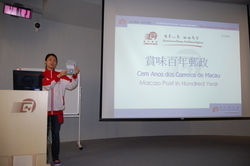
Item: S2-H01 "Macao Post in a Hundred Year"
Audience: Primary 1 to 3
Duration: 60 minutes
Content:
Introduce about the origin of postal services, the first set of stamps of Macao and the world, and the changes of pillar boxes and vehicles for transportation used by postman for delivery.
Interactive option:
Free visit or make "A Unique Envelope" (H01-1)
History of Macao Post
Macao Post has been established for more than 130 years since 1884. It has provided comprehensive services to the public. The different kinds of postal facilities distributed all over Macao mark the development of postal services together with the growth of the society. Can you imagine that the earliest post office was located in the house of the Postmaster General who ran the operation in the front hall of his house?
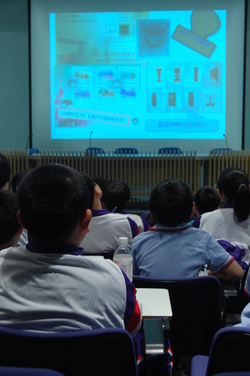
Item: S2-H02 "Look at Macao, Search for Macao Post"
Audience: Primary 4 or above
Duration: 60 minutes
Content:
See the distribution of old and new postal facilities from ancient times to modern days. Guess the year when Macao was shown on the stamps. Try to explain the changes of coast line and area of Macao with our knowledge in geography.
Foundations of Communication
Regardless of the distance, and whether we use human language or non-verbal language, mechanical or electronic methods, the process of message transmission always includes four procedures - coding, receiving, sending and decoding. Therefore, human beings have tried by all means to invent different types of communication tools and equipment in order to communicate and transmit messages in the fastest and most effective way.
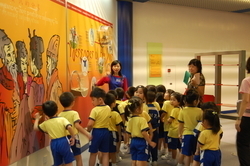
Item: S2-C01 "Non-Verbal Language"
Audience: Kindergarten 2 and 3
Duration: 60 minutes
Content:
Students are invited to join the interactive demonstration. They will use their body gestures (hand-shaking, with arms akimbo), facial expressions (happy, angry, sad, joyful) or simple signs/pictures (traffic lights) to express their thoughts. They will also listen to different sound tracks and collage masks to show different facial expressions.
Interactive option:
Take "Personal Picture Postcard" or "Sketch a Unique Face" (C01-1).
Foundations of Communication
Regardless of the distance, and whether we use human language or non-verbal language, mechanical or electronic methods, the process of message transmission always includes four procedures - coding, receiving, sending and decoding. Therefore, human beings have tried by all means to invent different types of communication tools and equipment in order to communicate and transmit messages in the fastest and most effective way.
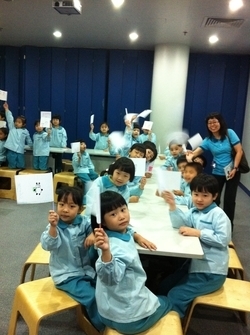
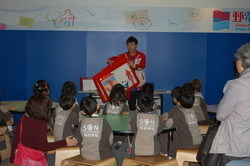
Item: S2-C02 "Shape and Color of Mail Boxes"
Audience: Kindergarten 2 and 3
Duration: 60 minutes
Content:
Students of K2 will be introduced about the pillar box of Macao. They will see the different mailboxes used in different countries. They will also be invited to choose a mini pillar box and tell its color and shape.
The national flag and the flag of the Macao Special Administrative Region and other countries will be introduced to K3 students. Students will be invited to participate in interactive games to see who will be the fastest to put together the magnetic flags.
Interactive option:
Take "Personal Picture Postcard", or color-filling "My Pillar Box" (K2: C02-1) / make "My Flag" (K3: C02-2)
Foundations of Communication
Regardless of the distance, and whether we use human language or non-verbal language, mechanical or electronic methods, the process of message transmission always includes four procedures - coding, receiving, sending and decoding. Therefore, human beings have tried by all means to invent different types of communication tools and equipment in order to communicate and transmit messages in the fastest and most effective way.
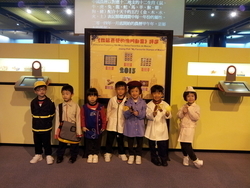
Item: S2-C03 "My Future Career"
Audience: Kindergarten 3 to Primary 3
Duration: 60 minutes
Content:
Introduce about different kinds of occupations, their uniforms and tools. Students will participate in role plays to learn about different kinds of occupation in Macao, which in turn will help them in their future career planning.
Interactive option:
Take "Personal Picture Postcard" of different occupations
Foundations of Communication
Regardless of the distance, and whether we use human language or non-verbal language, mechanical or electronic methods, the process of message transmission always includes four procedures - coding, receiving, sending and decoding. Therefore, human beings have tried by all means to invent different types of communication tools and equipment in order to communicate and transmit messages in the fastest and most effective way.

Item: S2-C04 "Message of the Sound"
Audience: Primary 1 to 3
Duration: 60 minutes
Content:
Students will learn about the structure of the throat and the functions of the tongue and teeth. They will also be invited to hear different sound tracks to identify different sounds.
Interactive option:
Free visit or make "Handmade Drum" (C04-1)
Foundations of Communication
Regardless of the distance, and whether we use human language or non-verbal language, mechanical or electronic methods, the process of message transmission always includes four procedures - coding, receiving, sending and decoding. Therefore, human beings have tried by all means to invent different types of communication tools and equipment in order to communicate and transmit messages in the fastest and most effective way.
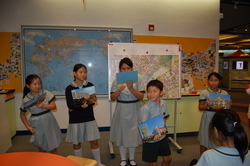
Item: S2-C05 "Decoding Maps"
Audience: Primary 4 to 6
Duration: 60 minutes
Content:
Students will obtain a lot of information from the signs and symbols on maps. They will be invited to complete an interesting "Decoding Maps" game and worksheets.
Interactive option:
Free visit
Foundations of Communication
Regardless of the distance, and whether we use human language or non-verbal language, mechanical or electronic methods, the process of message transmission always includes four procedures - coding, receiving, sending and decoding. Therefore, human beings have tried by all means to invent different types of communication tools and equipment in order to communicate and transmit messages in the fastest and most effective way.
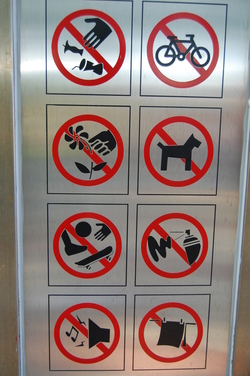
Item: S2-C06 "The World of Symbols"
Audience: Primary 4 to Form 2
Duration: 60 minutes
Content:
There are countless signs and symbols in the world. But how many of them do we know? Learning the correct meaning of signs not only will benefit us in our daily life, but it will also help us gain extra knowledge from it. Our facilitators will guide participants to create their own signs and symbols.
Interactive option:
Free visit
Foundations of Communication
Regardless of the distance, and whether we use human language or non-verbal language, mechanical or electronic methods, the process of message transmission always includes four procedures - coding, receiving, sending and decoding. Therefore, human beings have tried by all means to invent different types of communication tools and equipment in order to communicate and transmit messages in the fastest and most effective way.
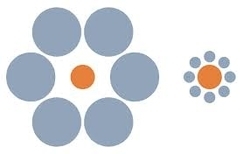
Item: S2-C07 "Lying Eyes"
Audience: Form 1 to 4
Duration: 60 minutes
Content:
Most people have experienced illusions, including those of "optics" and "hearing". Illusions exist because our brains make the wrong analysis of external stimuli, hence distorting our feelings. Optical illusions may be caused by over-stimulation that blunts the eyes, creating illusions such as complementary color and afterimage. Or consciously, the "image" is separated from the "background", forming an optical illusion of an image and its background. Besides, geometric optical illusion is created when the size, length, area, direction, angle, etc. of the objects as perceived by the human eye are obviously different from their actual measurements. Optical illusion is often used in design and creative work to produce special art and entertainment effects.
Interactive option:
Interactive games or demonstrations according to the level of the students. Free visit.
Postal Service
Postal service is one of the core businesses of Macao Post. Simply saying, when the post office receives mails from the senders, out-bound mails to the same destinations will be gathered and packed in the same mailbags for delivery via surface, sea or air routes to different parts of the world. In Macao, we often see the transport team of Macao Post traveling around the city busily to collect and deliver mailbags between the airport and the ports. The postmen also collect correspondences from pillar-boxes and postal stations all around Macao and then deliver them to the Mails Handling and Delivery Center for processing. On the other hand, when Macao Post receives import mailbags, postal staff will open it for classification and then sort the mails according to the distribution zones before delivering them to the recipients.
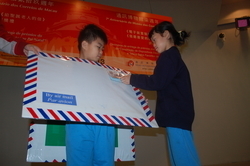
Item: S2-P01 "I Am a Letter - I"
Audience: Kindergarten 2 and 3
Duration: 60 minutes
Content:
Students will learn about the correct place to stick the stamp and how to write the name and address of the recipient on the envelope. Some students will be invited to join the role play ¡§A Letter¡¨ and see what is inside the envelope!
Interactive option:
Make "Handmade Foam Rubber Chop" (P01-1)
Postal Service
Postal service is one of the core businesses of Macao Post. Simply saying, when the post office receives mails from the senders, out-bound mails to the same destinations will be gathered and packed in the same mailbags for delivery via surface, sea or air routes to different parts of the world. In Macao, we often see the transport team of Macao Post traveling around the city busily to collect and deliver mailbags between the airport and the ports. The postmen also collect correspondences from pillar-boxes and postal stations all around Macao and then deliver them to the Mails Handling and Delivery Center for processing. On the other hand, when Macao Post receives import mailbags, postal staff will open it for classification and then sort the mails according to the distribution zones before delivering them to the recipients.
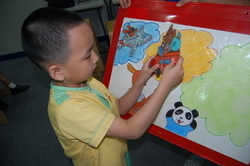
Item: S2-P02 "The New Postman - Kangaroo Ah Sing"
Audience: Kindergarten 2 and 3
Duration: 60 minutes
Content:
We shall make use of stories to explain postal services and introduce the location of post stations, postal services and show us the mail bags, correspondences and parcels. Students will be invited to help the main character, Ah Sing, to choose the correct means of transportation for delivering mails.
Interactive option:
Watch "Journey of a Mail" at Mini Theatre
Postal Service
Postal service is one of the core businesses of Macao Post. Simply saying, when the post office receives mails from the senders, out-bound mails to the same destinations will be gathered and packed in the same mailbags for delivery via surface, sea or air routes to different parts of the world. In Macao, we often see the transport team of Macao Post traveling around the city busily to collect and deliver mailbags between the airport and the ports. The postmen also collect correspondences from pillar-boxes and postal stations all around Macao and then deliver them to the Mails Handling and Delivery Center for processing. On the other hand, when Macao Post receives import mailbags, postal staff will open it for classification and then sort the mails according to the distribution zones before delivering them to the recipients.
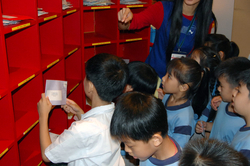
Item: S2-P03 "You Are the Best Postman"
Audience: Primary 1 to 3
Duration: 60 minutes
Content:
First, we shall visit the Mails Handling and Delivery Center of Macao Post (in case of peak season, this visit will not be arranged). Students will be explained about the basic calculation of postage and they can try weighing some letters. Students will also be invited to act as postmen in groups and use the sorting racks to sort mixed and indicated mails.
Interactive option:
Role-play as postman (P03-1) or group game (P03-2)
Postal Service
Postal service is one of the core businesses of Macao Post. Simply saying, when the post office receives mails from the senders, out-bound mails to the same destinations will be gathered and packed in the same mailbags for delivery via surface, sea or air routes to different parts of the world. In Macao, we often see the transport team of Macao Post traveling around the city busily to collect and deliver mailbags between the airport and the ports. The postmen also collect correspondences from pillar-boxes and postal stations all around Macao and then deliver them to the Mails Handling and Delivery Center for processing. On the other hand, when Macao Post receives import mailbags, postal staff will open it for classification and then sort the mails according to the distribution zones before delivering them to the recipients.
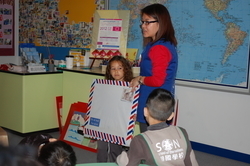
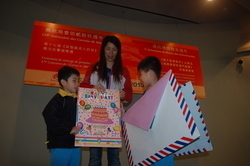
Item: S2-P04 "I Am a Letter - II"
Audience: Primary 1 to 3
Duration: 60 minutes
Content:
Why we need to post a letter and where we should post it? Students are invited to participate in a role play to learn the correct place to stick the stamp and write the name and address of the recipient and sender on the envelope. In this way, students will learn the entire process from writing a letter to posting it.
Interactive option:
Make "A Message to My Family" aerogramme (P04-1)
Warm reminder:
Students of lower levels can use dummy stamps to try mailing by dropping their letters into Pillar Box No. 888. Students of higher levels can try mailing their letters back to their home or school. Teachers will prepare the mailing address for students and buy real stamps at the Museum shop ($1.50 per letter).
Postal Service
Postal service is one of the core businesses of Macao Post. Simply saying, when the post office receives mails from the senders, out-bound mails to the same destinations will be gathered and packed in the same mailbags for delivery via surface, sea or air routes to different parts of the world. In Macao, we often see the transport team of Macao Post traveling around the city busily to collect and deliver mailbags between the airport and the ports. The postmen also collect correspondences from pillar-boxes and postal stations all around Macao and then deliver them to the Mails Handling and Delivery Center for processing. On the other hand, when Macao Post receives import mailbags, postal staff will open it for classification and then sort the mails according to the distribution zones before delivering them to the recipients.
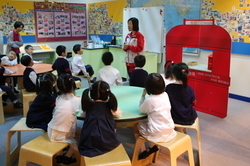
Item: S2-P05 "Postpedia"
Audience: Kindergarten 3 to Primary 1
Duration: 60 minutes
Content:
Do you know the difference between definite stamps and commemorative stamps? Try to categorize the stamps according to their themes and patterns. Participants will be invited to take part in the role play "Mini Postal Station" to experience human interaction by themselves.
Interactive option:
Take "Personal Picture Postcard"
Stamp and Collection
Since the United Kingdom issued the first stamp of the world in 1840, the chaotic charging method whereby the recipient has to pay for the postal fee is changed. Stamps are not only used to prepay for postal service, but they are also a mini ¡§name card¡¨ of the country for showing its customs, history and culture to other countries or regions. On this small piece of paper, people can enrich their knowledge from the wisdom and information included in it.
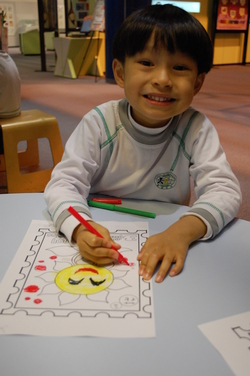
Item: S2-F01 "Shape and Color of Stamps"
Audience: Kindergarten 2 and 3
Duration: 60 minutes
Content:
After introducing the elements of a stamp, students will be invited to participate in interactive games to collage a stamp, and describe the shape, color or picture of the stamp.
Interactive option:
"Design Your Own Stamp"
Stamp and Collection
Since the United Kingdom issued the first stamp of the world in 1840, the chaotic charging method whereby the recipient has to pay for the postal fee is changed. Stamps are not only used to prepay for postal service, but they are also a mini ¡§name card¡¨ of the country for showing its customs, history and culture to other countries or regions. On this small piece of paper, people can enrich their knowledge from the wisdom and information included in it.
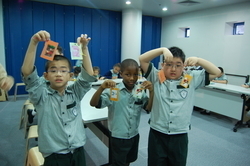
Item: S2-F02 "Kids, Let's Collect Stamps"
Audience: Primary 1 to 3
Duration: 60 minutes
Content:
Lower level students will be introduced about the elements of a stamp. When we collect stamps, we need to have some tools for conservation and collection. Higher level students will be introduced about the family of stamps, postal marks on the cover and those that cannot be used to cancel stamps.
Interactive option:
Make "Stamp Bookmark" (F02-1)
Stamp and Collection
Since the United Kingdom issued the first stamp of the world in 1840, the chaotic charging method whereby the recipient has to pay for the postal fee is changed. Stamps are not only used to prepay for postal service, but they are also a mini ¡§name card¡¨ of the country for showing its customs, history and culture to other countries or regions. On this small piece of paper, people can enrich their knowledge from the wisdom and information included in it.
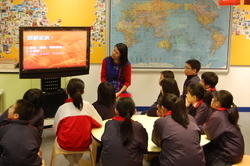
Item: S2-F03 "Global Stamps Geography"
Audience: Primary 4 to 6
Duration: 60 minutes
Content:
Students will learn geography from a stamp, and the classification, themes and pictures of stamps. They will learn about the issuing country and the four-color printing of stamps.
Interactive option:
Free Visit
Stamp and Collection
Since the United Kingdom issued the first stamp of the world in 1840, the chaotic charging method whereby the recipient has to pay for the postal fee is changed. Stamps are not only used to prepay for postal service, but they are also a mini ¡§name card¡¨ of the country for showing its customs, history and culture to other countries or regions. On this small piece of paper, people can enrich their knowledge from the wisdom and information included in it.
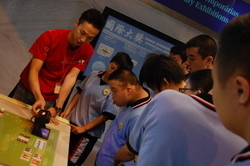
Item: S2-F04 "3-Dimensional Stamps"
Audience: Primary 4 to 6
Duration: 60 minutes
Content:
While stamps could be of different shapes and perforations, they can also be printed on different types of materials or in 3-dimensional format. Students will use the magnifying glass in the gallery to see the stamps for themselves.
Interactive option:
Free visit or select 1 additional 30-minute workshop "Fragrant Stamps" (F04-1).
Stamp and Collection
Since the United Kingdom issued the first stamp of the world in 1840, the chaotic charging method whereby the recipient has to pay for the postal fee is changed. Stamps are not only used to prepay for postal service, but they are also a mini ¡§name card¡¨ of the country for showing its customs, history and culture to other countries or regions. On this small piece of paper, people can enrich their knowledge from the wisdom and information included in it.
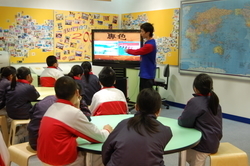

Item: S2-F05 "How Macao Stamps Are Made"
Audience: Primary 4 or above
Duration: 60 minutes
Content:
Can you imagine how a picture can be changed into a stamp? Let us find out the production process of Macao stamps and the stamp family.
Interactive option:
Free Visit
Stamp and Collection
Since the United Kingdom issued the first stamp of the world in 1840, the chaotic charging method whereby the recipient has to pay for the postal fee is changed. Stamps are not only used to prepay for postal service, but they are also a mini ¡§name card¡¨ of the country for showing its customs, history and culture to other countries or regions. On this small piece of paper, people can enrich their knowledge from the wisdom and information included in it.
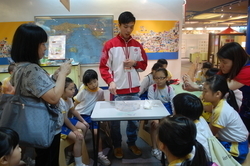
Item: S2-F06 "All About Stamps Colours"
Audience: Primary 5 to Form 3
Duration: 60 minutes
Content:
When a stamp is continuously exposed under a humid or shiny environment, some irrevocable changes may take place. For instance, the material or color may change. Let us learn ways to conserve stamps.
Interactive option:
Free Visit
General Mathematics
Mathematics has a long history. Its origins date back from practical human activities such as measuring and trading. In the ¡§Rites of Zhou¡¨ of the Western Zhou Dynasty, mathematics is one of the Six Arts. In the Western world, mathematics originates from Greek, which means learning, study and science. In ancient China, mathematics is called ¡§Arithmetic¡¨, which refers to the skill of using counting rods. ¡§The Nine Chapters on the Mathematical Art¡¨ does not only refer to land area, exchange of commodities, proportional distribution, consultations on works and taxation, but it is also the first book in the history of mathematics to bring up the ¡§System of Linear Equations¡¨ and explain the applications of ¡§Gougu Theorem¡¨ (known as the Pythagorean Theorem). The term ¡§Mathematics¡¨ only appeared in China until the Song and Yuan Dynasty. Chinese Abacus is highly popularized in the Ming Dynasty. In July 1935, the Chinese Mathematical Society was founded in Shanghai.
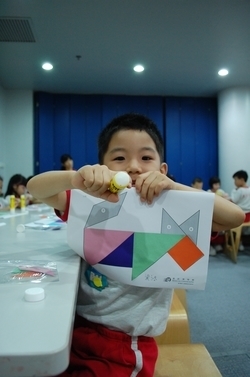
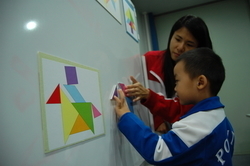
Item: S2-S01 "Tangram Fun"
Audience: Kindergarten 2 and 3
Duration: 60 minutes
Content:
Through playing tangrams, participants will learn different shapes, colors and strengthen their cognition. In the game ¡§My Creative Tangram¡¨, participants will create objects of different shapes with the tangrams.
Interative option:
Tangram workshop (S01-1)
General Mathematics
Mathematics has a long history. Its origins date back from practical human activities such as measuring and trading. In the ¡§Rites of Zhou¡¨ of the Western Zhou Dynasty, mathematics is one of the Six Arts. In the Western world, mathematics originates from Greek, which means learning, study and science. In ancient China, mathematics is called ¡§Arithmetic¡¨, which refers to the skill of using counting rods. ¡§The Nine Chapters on the Mathematical Art¡¨ does not only refer to land area, exchange of commodities, proportional distribution, consultations on works and taxation, but it is also the first book in the history of mathematics to bring up the ¡§System of Linear Equations¡¨ and explain the applications of ¡§Gougu Theorem¡¨ (known as the Pythagorean Theorem). The term ¡§Mathematics¡¨ only appeared in China until the Song and Yuan Dynasty. Chinese Abacus is highly popularized in the Ming Dynasty. In July 1935, the Chinese Mathematical Society was founded in Shanghai.
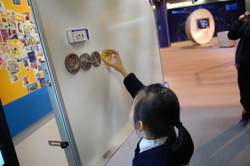
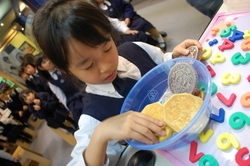
Item: S2-S02 "How Much Do You Know about MOP?"
Audience: Primary 1 to 3
Duration: 60 minutes
Content:
From the introduction of Macao currency, participants will learn the face value of money and patterns on coins. In the interactive game, participants will experience buying things in our daily life and learn paying and getting change.
Interative option:
"$10 Shopping" group game (S02-01)
General Mathematics
Mathematics has a long history. Its origins date back from practical human activities such as measuring and trading. In the "Rites of Zhou" of the Western Zhou Dynasty, mathematics is one of the Six Arts. In the Western world, mathematics originates from Greek, which means learning, study and science. In ancient China, mathematics is called "Arithmetic", which refers to the skill of using counting rods. "The Nine Chapters on the Mathematical Art" does not only refer to land area, exchange of commodities, proportional distribution, consultations on works and taxation, but it is also the first book in the history of mathematics to bring up the "System of Linear Equations" and explain the applications of "Gougu Theorem" (known as the Pythagorean Theorem). The term "Mathematics" only appeared in China until the Song and Yuan Dynasty. Chinese Abacus is highly popularized in the Ming Dynasty. In July 1935, the Chinese Mathematical Society was founded in Shanghai.
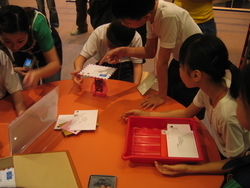
Item: S2-S03 "Mathematics on Stamps"
Audience: Primary 1 to 6
Duration: 60 minutes
Content:
Postage is calculated based on the weight of the mail or parcel and destination. Let us make use of our knowledge in Mathematics to calculate the postage by matching with stamps of different values.
Interactive option:
Math Worksheet (P1 - P3 S03-1), Design Your Own Box for Parcels (P4 - P6 S03-2).
General Mathematics
Mathematics has a long history. Its origins date back from practical human activities such as measuring and trading. In the "Rites of Zhou" of the Western Zhou Dynasty, mathematics is one of the Six Arts. In the Western world, mathematics originates from Greek, which means learning, study and science. In ancient China, mathematics is called "Arithmetic", which refers to the skill of using counting rods. "The Nine Chapters on the Mathematical Art" does not only refer to land area, exchange of commodities, proportional distribution, consultations on works and taxation, but it is also the first book in the history of mathematics to bring up the "System of Linear Equations" and explain the applications of "Gougu Theorem" (known as the Pythagorean Theorem). The term "Mathematics" only appeared in China until the Song and Yuan Dynasty. Chinese Abacus is highly popularized in the Ming Dynasty. In July 1935, the Chinese Mathematical Society was founded in Shanghai.
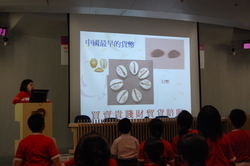
Item: S2-S04 "All about Numbers"
Audience: Primary 4 to 6
Duration: 60 minutes
Content:
Participants will learn the currencies of different countries as well as their names and symbols. In the ¡§Chinese Numerals¡¨ game, students will learn the Simple (Xiaoxie), Complicated (Daxie) and ¡§Huama¡¨ forms of writing Chinese numerals. They will be invited to try writing big dummy cheques to practice different ways of expressing numbers.
Interative option:
Free Visit
General Mathematics
Mathematics has a long history. Its origins date back from practical human activities such as measuring and trading. In the "Rites of Zhou" of the Western Zhou Dynasty, mathematics is one of the Six Arts. In the Western world, mathematics originates from Greek, which means learning, study and science. In ancient China, mathematics is called "Arithmetic", which refers to the skill of using counting rods. "The Nine Chapters on the Mathematical Art" does not only refer to land area, exchange of commodities, proportional distribution, consultations on works and taxation, but it is also the first book in the history of mathematics to bring up the "System of Linear Equations" and explain the applications of "Gougu Theorem" (known as the Pythagorean Theorem). The term "Mathematics" only appeared in China until the Song and Yuan Dynasty. Chinese Abacus is highly popularized in the Ming Dynasty. In July 1935, the Chinese Mathematical Society was founded in Shanghai.
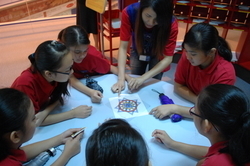
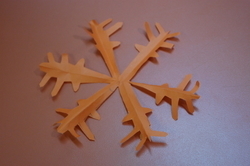
Item: S2-S05 "Symmetry"
Audience: Primary 5 to 6
Duration: 60 minutes
Content:
Learn about "Reflection Symmetry" and "Rotational Symmetry". "Symmetry" is widely applied in architecture, music, literature, art, etc. to add beauty to them. Students will be invited to join interactive games and do hands-on activity.
active option:
"Origami - Paper Windmill" (Primary 5: S05-1), "Paper Cutting - Snowflakes" (Primary 6: S05-2). Free visit.
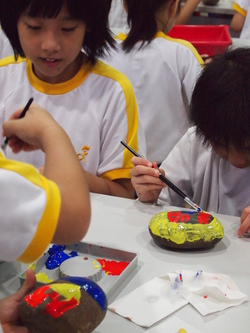
Item: S2-W01 "Message on the Stone"
Audience: Primary 4 to 6
Duration: 60 minutes
Content:
We shall introduce the ways to convey messages before the invention of written words and students will draw their messages on the stones.
Charge:
Held in the museum - Free of charge. At schools - MOP20.00 per student.
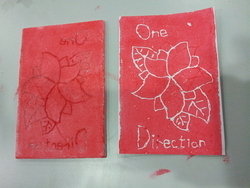
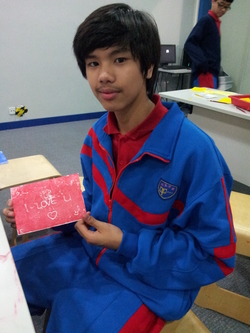
Item: S2-W02 "Postcard Stereotype Printing"
Audience: Primary 4 to 6
Duration: 60 minutes
Content:
Participants will be introduced about the difference between regular postcard and maximum card? In addition to the origin, characteristics, types and materials of postcards, participants will also learn the basic letter-writing format and other conventions. Then they will try printing postcards by first engraving foam boards with pencils, and then rolling paint on the lifted surface and finally printing the picture on a blank postcard.
Charge:
Held in the museum - Free of charge. At schools - MOP20.00 per student.
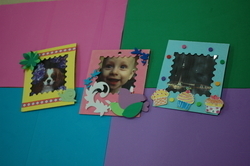
Item: S2-W03 "Funny Picture Frame DIY"
Audience: Primary 4 or above
Duration: 60 minutes
Content:
Students will use colored cardboards, molds and embossing machine to make different shapes and patterns. They will use these materials to create their unique picture frames.
Charge:
Held in the museum - Free of charge. At schools - MOP20.00 per student.
About CMM
Contact US
Others
Other Websites
Number of Visitors:
Last Modified Date: 10/03/2025